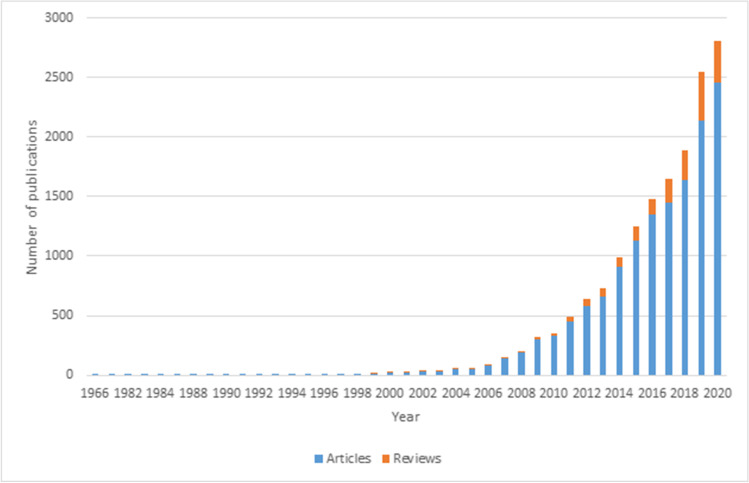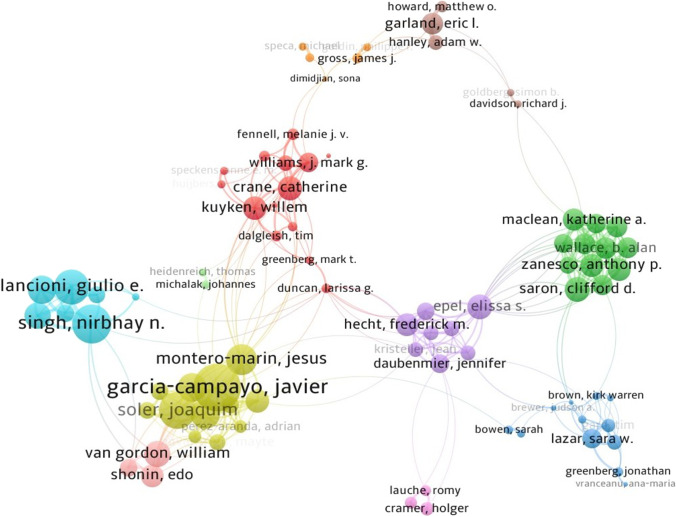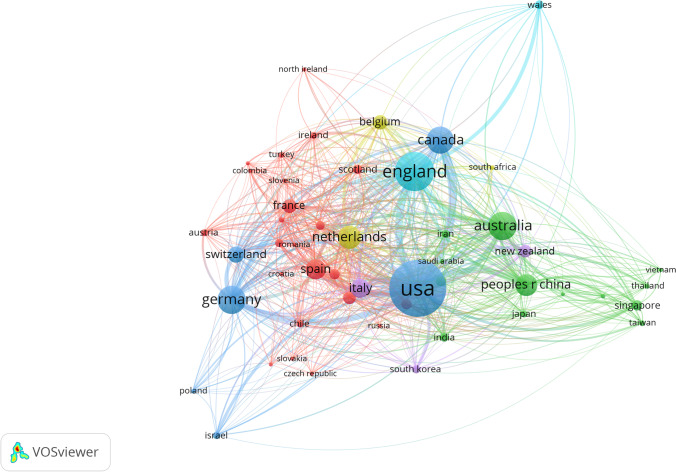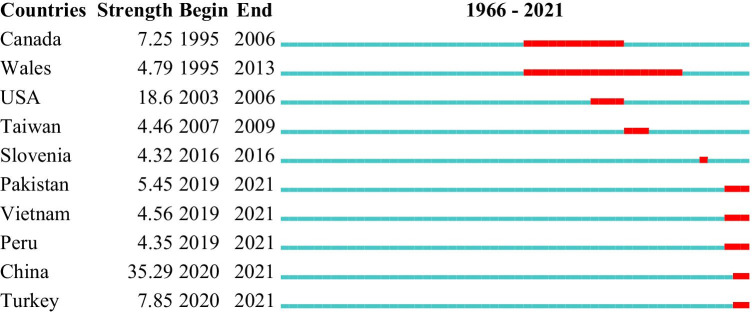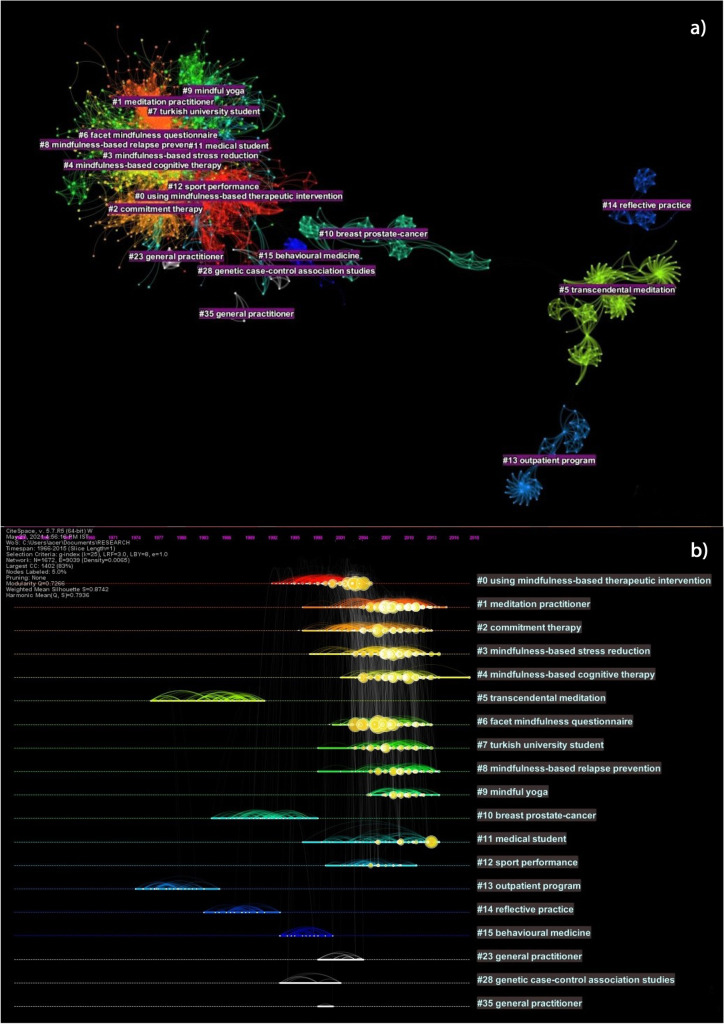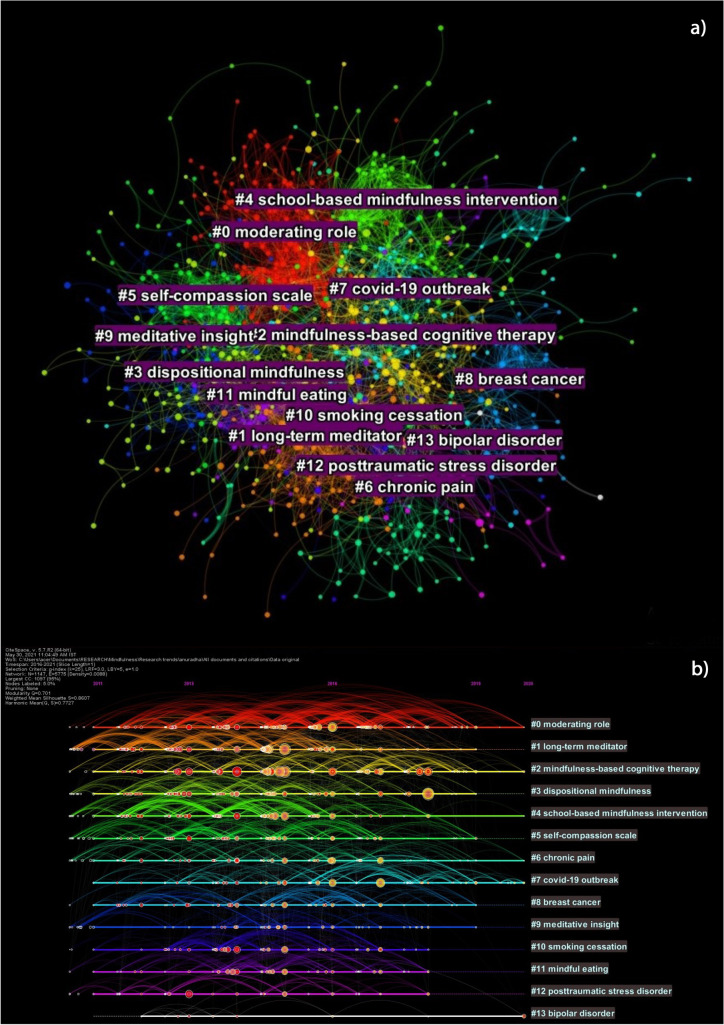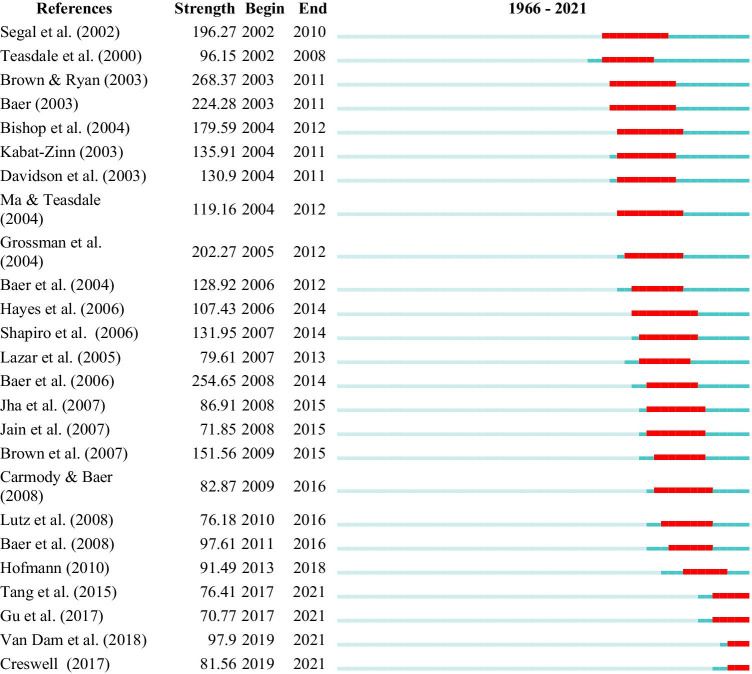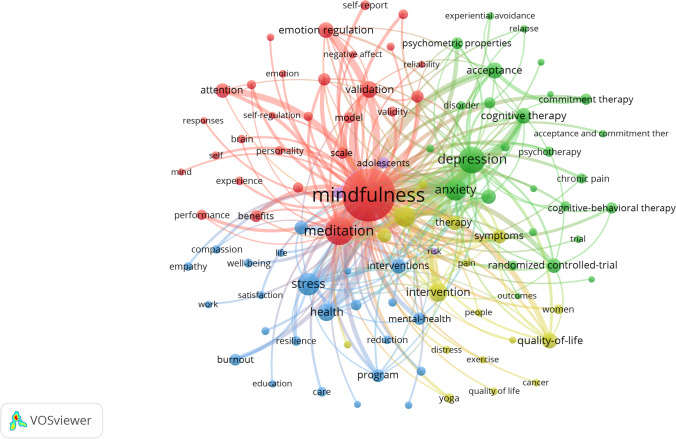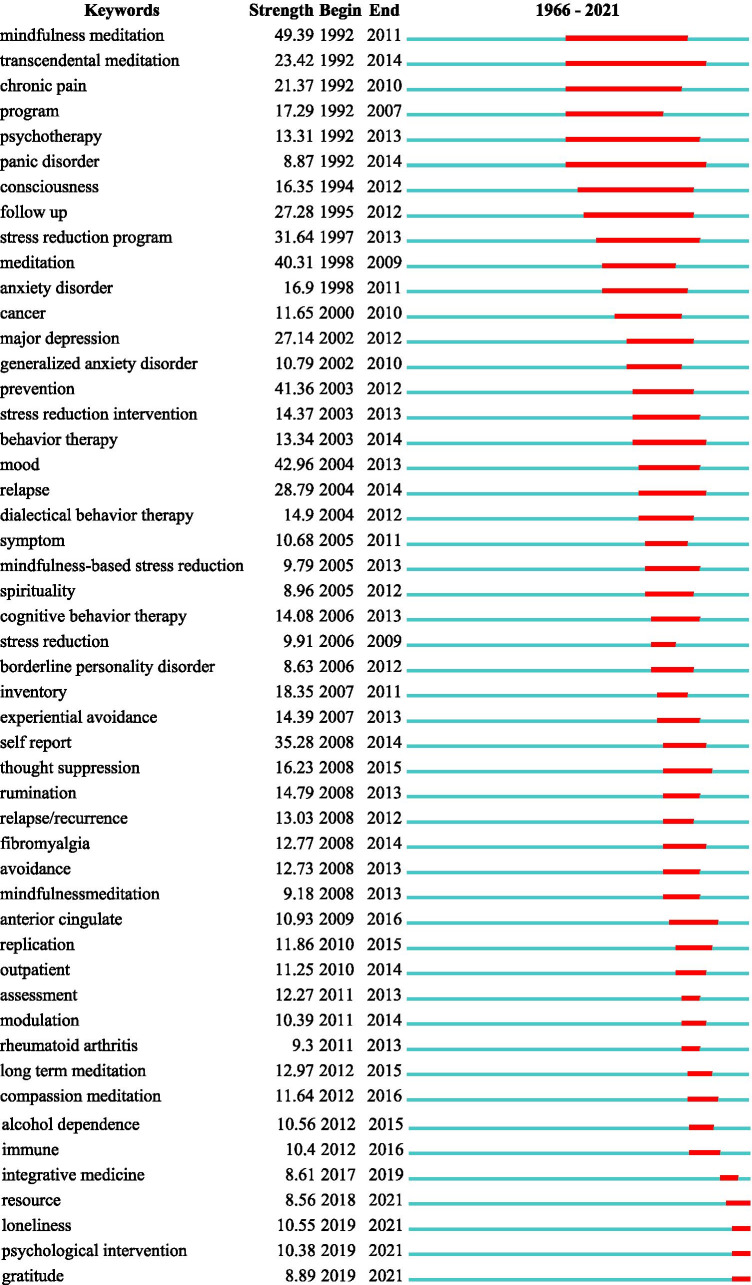Abstract
Objectives
This study aimed to identify historical developments, active research areas, and emerging trends within scientific literature on mindfulness published so far, using bibliometric methods. We also aimed to identify prominent journals, authors, organizations, and countries in the field of mindfulness.
Methods
Articles or reviews which mention mindfulness in the title, abstract, or keywords were identified using the Web of Science. A descriptive summary of the literature was obtained from the Web of Science Analysis tool. Country collaboration, co-authorship, and keyword co-occurrence networks were visualized using VOSviewer. CiteSpace, which uses document co-citation analysis, was used to identify emerging trends and transient patterns in the literature.
Results
From 1966 to 2021, 16,581 publications on mindfulness were identified. There has been an exponential growth of publications since 2006. Almost half (47%) of the publications were in psychology and about one-fifth (20.8%) in psychiatry. The most prolific journal was Mindfulness (contributing 7% of all publications) and the most prolific author was Eric L. Garland. The vast majority of publications originated from Western countries but representation from Asian countries has increased. The most frequently co-occurring keywords were meditation, depression, stress, and anxiety. Co-citation analysis of the early period (1966–2015) revealed how scholarly work on spiritual themes has inspired early mindfulness research. Recent trends (2016–2021) revealed a rising interest in mechanisms and moderators, long-term meditation, neuroscientific studies, and smartphone/online delivery of interventions.
Conclusions
This comprehensive bibliometric study summarized and visualized 55 years of mindfulness research, revealing pivotal points, active research areas, and emerging trends.
Keywords: Mindfulness, Bibliometrics, Trends, Patterns, Co-citation analysis
Mindfulness, which originates from Buddhist contemplative practices dating back more than 25 centuries, has recently enjoyed a surge of popularity in the Western hemisphere, pervading a variety of disciplines (Shapiro & Weisbaum, 2020). Adaptation of Buddhist mindfulness techniques into a secular therapeutic intervention in the 1980s in the United States, namely the mindfulness-based stress reduction (MBSR) programme, probably sparked the interest of researchers from myriad disciplines to scientifically and systematically study these meditative practices (Kabat-Zinn, 1982; Shapiro & Weisbaum, 2020). Since then, a large body of research evidence has accrued in support of the beneficial effects of mindfulness on diverse mental and physical health attributes (Creswell, 2017; Khoury et al., 2013).
A rapid growth of literature on mindfulness since the turn of the century was recognized earlier (Pagnini & Philips, 2015; Van Dam et al., 2018). A few studies have previously attempted to identify trends within mindfulness research. An analysis of 1056 articles published in the journal Mindfulness during 2010–2019 showed a few salient trends: increased diversification of the topics being explored as shown by the greater variety of recurring keywords and an increase in the proportion of articles from Asia were noted (Toniolo–Barrios et al., 2020). An analysis of trends in systematic reviews on mindfulness revealed an average increase of 19% per year in the number of reviews published from 2003 to 2015 (Chiesa et al., 2017). A study by Valerio (2016) demonstrated how mindfulness literature has become “disembedded” from Buddhist contexts over time: The ratio of literature on Buddhism to that on mindfulness flipped from 4.6:1 before 2008 to 1:1.8 over the following 5 years, and the meditation-to-mindfulness publication ratio dropped from 12.9:1 in 1993–1997 to approximately 1:1 around 2010.
With the explosive growth in the production of research literature, new approaches are required to review and analyze trends within knowledge domains (Chen, 2006; van Eck & Waltman, 2010). Bibliometrics, defined originally by Pritchard (1969) as “the application of mathematical and statistical methods to books and other media of communication,” is now widely used to study trends within a body of literature (Thompson & Walker, 2015). Application of bibliometrics to study mindfulness literature has so far been limited to the scope of a single journal and short time frame (Toniolo–Barrios et al., 2020), a single type of publication (Chiesa et al., 2017), or a narrow research question (Valerio, 2016). Therefore, we aimed to perform a broader and comprehensive bibliometric analysis of the mindfulness literature, in order to elucidate historical developments, emerging trends, and active research areas within this rapidly expanding domain of scientific knowledge.
Method
Source of Data
Bibliographic data for the analyses were extracted from the Web of Science (WoS) Core Collection. WoS contains over 21,100 peer-reviewed, scholarly journals published worldwide in over 250 disciplines within sciences, social sciences, and arts & humanities. The availability of citation data makes WoS data suitable for bibliometric analyses including co-citation analysis.
Search Strategy and Data Retrieval
A search was performed on WoS for all documents with “mindfulness” as a topic; this identifies all documents with the word “mindfulness” in the title, abstract, or keywords. Only the documents of the article or review type were included; other document types such as meeting proceedings, book reviews, and letters were excluded. Bibliographic data were exported as “full records with cited references.”
Data Analysis and Visualization
Analysis and visualization of the bibliometric data were performed using three analytical tools — the WoS Analysis tool; VOSviewer (version 1.6.16), and CiteSpace (version 5.7.R2). Additionally, ArcGIS 10.8.1 was used to draw a world map of country trends.
Web of Science Analysis
Descriptive analyses summarizing information about the most prominent authors, countries, organizations, journals, and publication years were tabulated or graphically presented using the WoS Analysis tool.
VOSviewer
VOSviewer is a software for creating and visualizing maps based on network data (van Eck & Waltman, 2010). Country collaboration, co-authorship, and keyword co-occurrence networks within the mindfulness literature were visualized using VOSviewer. In VOSviewer terminology, a cluster is a set of items closely associated with one another in a map (items can be authors, countries, keywords, etc.). One item may belong to only one cluster. In the visualization of a map, items with greater importance (e.g., total link strength) are shown with larger labels and larger circles. For some items, the label may not be displayed in order to avoid overlapping labels. The color of an item is determined by the cluster to which it belongs. A link is a connection between two items. Examples of links are co-authorship links between authors and countries and co-occurrence links between keywords. Each link has a strength, with a numerical value assigned. For example, the strength of a co-authorship link indicates the number of publications two researchers have co-authored, whereas a co-occurrence link indicates the number of publications in which two keywords occur together. The thickness of the lines connecting items indicates the link strength. For a given item, total link strength indicates the total strength of the links it has with other items, e.g., in the case of co-authorship links between authors, the total link strength indicates the total strength of the co-authorship links of a given author with other authors.
CiteSpace
CiteSpace is a Java application developed for visualizing emerging trends and transient patterns in a knowledge domain using document co-citation analysis (Chen, 2006). Co-citation refers to the frequency of two documents being cited together; the more co-citations two documents receive, the more likely they are semantically related. CiteSpace has drawn from earlier concepts introduced by Small (1973) to identify underlying intellectual structures. WoS data on mindfulness were split into two arbitrary periods in order to visualize earlier (1966–2015) and recent (2016–2021) trends in mindfulness research. Even though the earlier period was much longer, the number of publications in this period was about half of that in the recent period. Each period was separately visualized to explore historical developments, major research areas, and trends. CiteSpace uses computer algorithms to label co-citation clusters automatically; the log-likelihood ratio method is generally preferred. CiteSpace provides metrics of structural and temporal properties of the network, clusters, and nodes. Structural metrics include betweenness centrality, modularity, and silhouette index. The betweenness centrality (or centrality), based on concepts of Freeman (1978), measures the extent to which a node is in the middle of a path that connects other nodes in the network: High centrality values identify potentially revolutionary scientific publications (Chen, 2006). Temporal metrics include citation burstness, derived from Kleinberg’s (2002) burst detection algorithm. CiteSpace allows detection of citation bursts for any type of node (publications, countries, keywords, etc.) over the period studied. Citation bursts indicate sudden surges in interest within the research community towards a particular node during a particular period of time. Sigma is a combined indicator of both structural and temporal properties of a node.
Results
Number of Publications over Time
From 1966 to 2021, 16,581 publications (14,682 articles and 1899 reviews) referring to mindfulness in the title, abstract, or keywords were identified on the WoS. The first publication was “Mindfulness of sensation” published in 1966 in by W. Pe in Psychologia, a Japanese journal. The next two articles were published in 1979 (a theoretical paper on “Empathy and Mindfulness” by R. Schuster) and 1982 (Kabat-Zinn’s preliminary study introducing an outpatient program of mindfulness for chronic pain), respectively.
The number of publication remained less than 100 per year until 2006, and since then, there has been an exponential growth in publications on mindfulness, reaching 2808 publications in 2020 (Fig. 1). The number of publications increased by an average of 23.5% per year from 2010 to 2020. The number of reviews has also increased similarly, reaching a peak of 405 in 2019. Two-thirds of all publications (n = 11,164, 67%) were in the period of 2016–2021.
Fig. 1.
Number of publications on mindfulness indexed in Web of Science 1966–2020
Research Areas
Based on research areas as categorized on WoS, almost half (47%) of the publications on mindfulness were in psychology, and about one-fifth (20.8%) were in psychiatry. Table 1 lists and compares the 25 most prominent research areas in the periods of 1966–2015 and 2015–2021, in order to illustrate changing trends. Publications in psychology have dropped from 50.5 to 45.2% whereas a slight increase from 19.7 to 21.4% is seen for psychiatry. Of note, there is a recent increase in publications in public environmental occupational health (from 3.3 to 5.2%) and general internal medicine (2.2 to 3.5%) and a decline in publications in the area of religion (from 3.2 to 1.7%).
Table 1.
Top 25 research areas in mindfulness (1966–2015 and 2016–2021)
| 1966–2015 | 2016–2021 | ||||
|---|---|---|---|---|---|
| Research area | Number of publications | % | Research area | Number of publications | % |
| 1. Psychology | 2776 | 50.5 | 1. Psychology | 5044 | 45.2 |
| 2. Psychiatry | 1083 | 19.7 | 2. Psychiatry | 2386 | 21.4 |
| 3. Neurosciences neurology | 424 | 7.7 | 3. Neurosciences neurology | 790 | 7.1 |
| 4. Education educational research | 328 | 5.9 | 4. Education educational research | 677 | 6.1 |
| 5. Integrative complementary medicine | 252 | 4.6 | 5. Public environmental occupational health | 584 | 5.2 |
| 6. Business economics | 200 | 3.6 | 6. Nursing | 499 | 4.5 |
| 7. Nursing | 181 | 3.3 | 7. Integrative complementary medicine | 398 | 3.6 |
| 8. Public environmental occupational health | 181 | 3.3 | 8. Social sciences other topics | 390 | 3.5 |
| 9. Religion | 180 | 3.2 | 9. General internal medicine | 389 | 3.5 |
| 10. Social sciences other topics | 169 | 3.1 | 10. Health care sciences services | 382 | 3.4 |
| 11. Substance abuse | 153 | 2.8 | 11. Business economics | 371 | 3.3 |
| 12. Health care sciences services | 130 | 2.4 | 12. Science technology other topics | 262 | 2.3 |
| 13. General internal medicine | 123 | 2.2 | 13. Rehabilitation | 239 | 2.1 |
| 14. Rehabilitation | 114 | 2.0 | 14. Oncology | 219 | 1.9 |
| 15. Social work | 103 | 1.9 | 15. Family studies | 207 | 1.8 |
| 16. Oncology | 99 | 1.8 | 16. Substance abuse | 200 | 1.8 |
| 17. Family studies | 93 | 1.7 | 17. Environmental sciences ecology | 195 | 1.7 |
| 18. Science technology other topics | 81 | 1.5 | 18. Social work | 193 | 1.7 |
| 19. Behavioral sciences | 78 | 1.4 | 19. Religion | 192 | 1.7 |
| 20. Philosophy | 59 | 1.1 | 20. Behavioral sciences | 158 | 1.4 |
| 21. Geriatrics gerontology | 53 | 0.96 | 21. Geriatrics gerontology | 124 | 1.1 |
| 22. Research experimental medicine | 53 | 0.96 | 22. Research experimental medicine | 116 | 1.0 |
| 23. Anesthesiology | 50 | 0.90 | 23. Pharmacology pharmacy | 115 | 1.0 |
| 24. Biomedical social sciences | 41 | 0.74 | 24. Pediatrics | 111 | 0.99 |
| 25. Pediatrics | 41 | 0.74 | 25. Medical informatics | 97 | 0.86 |
Most Cited Publications
Out of the 10 most cited publications on mindfulness, 7 were review articles. The two most cited publications were empirical research articles; these two articles validated the Mindful Awareness and Attention Scale (MAAS) and the five facet mindfulness questionnaire (FFMQ), respectively (Baer et al., 2006; Brown & Ryan, 2003). The former had the highest average citations per year. Also included among the 10 most cited empirical articles were two other studies investigating the validity of mindfulness measures (Baer et al., 2004; Baer et al., 2008); pioneering studies which introduced MBSR for chronic pain (Kabat-Zinn, 1982) and anxiety (Kabat-Zinn et al., 1992) and MBCT for depressive relapse prevention (Teasdale et al., 2000), and one of the first studies on effects of mindfulness on brain function and immunity (Davidson et al., 2003). Table 2 lists the most cited empirical articles and reviews on mindfulness.
Table 2.
Top 10 most cited empirical and review articles on mindfulness
| Article name | Author (year) | Journal | Total citations (citations/year) |
|---|---|---|---|
| Empirical articles | |||
| 1. The benefits of being present: Mindfulness and its role in psychological well-being | Brown and Ryan (2003) | Journal Of Personality And Social Psychology | 4719 (248) |
| 2. Using self-report assessment methods to explore facets of mindfulness | Baer et al. (2006) | Assessment | 2940 (184) |
| 3. An outpatient program in behavioral medicine for chronic pain patients based on the practice of mindfulness meditation-theoretical considerations and preliminary-results | Kabat-Zinn (1982) | General Hospital Psychiatry | 1698 (42) |
| 4. Prevention of relapse/recurrence in major depression by mindfulness-based cognitive therapy | Teasdale et al. (2000) | Journal Of Consulting And Clinical Psychology | 1619 (74) |
| 5. Alterations in brain and immune function produced by mindfulness meditation | Davidson et al. (2003) | Psychosomatic Medicine | 1251 (66) |
| 6. Construct validity of the five facet mindfulness questionnaire in meditating and nonmeditating samples | Baer et al. (2008) | Assessment | 1178 (84) |
| 7. Assessment of mindfulness by self-report—The Kentucky inventory of mindfulness skills | Baer et al. (2004) | Assessment | 1029 (57) |
| 8. Open hearts build lives: Positive emotions, induced through loving-kindness meditation, build consequential personal resources | Fredrickson et al. (2008) | Journal of Personality and Social Psychology | 995 (76.5) |
| 9. Effectiveness of a meditation-based stress reduction program in the treatment of anxiety disorders | Kabat-Zinn et al. (1992) | American Journal of Psychiatry | 907 (30) |
| 10. Relationships between mindfulness practice and levels of mindfulness, medical and psychological symptoms and well-being in a mindfulness-based stress reduction program | Carmody and Baer (2008) | Journal of Behavioral Medicine | 830 (59) |
| Review articles | |||
| 1. Mindfulness: A proposed operational definition | Bishop et al. (2004) | Clinical Psychology-Science And Practice | 2662 (148) |
| 2. Mindfulness-based interventions in context: Past, present, and future | Kabat-Zinn (2003) | Clinical Psychology-Science And Practice | 2653 (140) |
| 3. Acceptance and commitment therapy: Model, processes and outcomes | Hayes et al. (2006) | Behaviour Research And Therapy | 2418 (151) |
| 4. Mindfulness training as a clinical intervention: A conceptual and empirical review | Baer (2003) | Clinical Psychology-Science And Practice | 2034 (107) |
| 5. Mindfulness-based stress reduction and health benefits—A meta-analysis | Grossman, et al. (2004) | Journal Of Psychosomatic Research | 2017 (112) |
| 6. The effect of mindfulness-based therapy on anxiety and depression: A meta-analytic review | Hofmann et al. (2010) | Journal Of Consulting And Clinical Psychology | 1731 (144) |
| 7. Self-determination theory: A macrotheory of human motivation, development, and health | Deci and Ryan (2008) | Canadian Psychology-Psychologie Canadienne | 1649 (118) |
| 8. Mindfulness: Theoretical foundations and evidence for its salutary effects | Brown et al. (2007) | Psychological Inquiry | 1410 (94) |
| 9. Mechanisms of mindfulness | Shapiro et al. (2006) | Journal Of Clinical Psychology | 1326(83) |
| 10. How does mindfulness meditation work? Proposing mechanisms of action from a conceptual and neural perspective | Hölzel et al. (2011) | Perspectives on psychological science | 1132 (103) |
The most cited review article provided an operational definition of mindfulness (Bishop et al., 2004). Other highly cited reviews included a few meta-analyses of the efficacy of mindfulness on health conditions, several theoretical papers on mindfulness and related concepts, and two reviews exploring mechanisms of action of mindfulness. All of the 10 most cited research and review articles were published in or before 2011. Among publications produced after 2011, a review on neuroscience of mindfulness meditation by Tang et al. (2015) had received the highest citations per year (109 citations/year).
Most Prolific Journals
WoS listed 3644 journals with at least one publication on mindfulness. There were 338 journals with at least 10 publications (accounting for 59% of all publications). Table 3 lists the 25 journals with the highest number of publications related to mindfulness. Mindfulness, published by Springer, had by far the largest number of publications (n = 1169, 7.05%) on mindfulness. The top 10 journals contributed to 15.7% of the publications, whereas the top 25 journals contributed to 22%.
Table 3.
Top 25 most prolific journals publishing mindfulness research
| Journal | Number of publications | Percentage | Journal impact factora |
|---|---|---|---|
| 1. Mindfulness | 1169 | 7.05 | 3.581 |
| 2. Frontiers in Psychology | 373 | 2.25 | 2.067 |
| 3. Personality and Individual Differences | 206 | 1.24 | 2.311 |
| 4. PLOS One | 170 | 1.02 | 2.740 |
| 5. Journal of Alternative and Complementary Medicine | 129 | 0.78 | 2.256 |
| 6. Journal of Clinical Psychology | 126 | 0.76 | 2.138 |
| 7. Behaviour Research And Therapy | 116 | 0.70 | 4.500 |
| 8. Journal of Contextual Behavioral Science | 113 | 0.68 | 1.523 |
| 9. Journal of Child and Family Studies | 99 | 0.59 | 1.310 |
| 10. International Journal of Environmental Research and Public Health | 97 | 0.58 | 2.849 |
| 11. Current Psychology | 93 | 0.56 | 4.673 |
| 12. Consciousness and Cognition | 85 | 0.51 | 2.044 |
| 13. Journal of Affective Disorders | 81 | 0.49 | 3.892 |
| 14. BMJ Open | 78 | 0.47 | 2.496 |
| 15. Frontiers in Human Neuroscience | 77 | 0.46 | 3.209 |
| 16. Complementary Therapies in Medicine | 70 | 0.42 | 2.063 |
| 17. Current Opinion in Psychology | 65 | 0.39 | 4.162 |
| 18. Frontiers in Psychiatry | 65 | 0.39 | 3.532 |
| 19. Journal of Consulting and Clinical Psychology | 65 | 0.39 | 4.632 |
| 20. Trials | 64 | 0.39 | 1.883 |
| 21. Explore: The Journal of Science and Healing | 63 | 0.38 | 1.485 |
| 22. Complementary Therapies in Clinical Practice | 61 | 0.37 | 1.770 |
| 23. Clinical Psychology Psychotherapy | 59 | 0.36 | 2.477 |
| 24. Clinical Psychology Review | 59 | 0.36 | 10.225 |
| 25. Cognitive Therapy and Research | 56 | 0.338 | 2.603 |
abased on 2019 Journal Citation Reports-Clarivate Analytics
Authors
Most Prolific Authors
Authors with the highest number of publications on mindfulness indexed in WoS are listed in Table 4. The author with the highest number of citations for his publications on mindfulness was Zindel Segal (9469 citations for 44 publications), who played an integral role in introducing MBCT.
Table 4.
Top 25 most prolific authors in mindfulness research
| Author name | Country | Institution | No. of publications | No. of citations |
|---|---|---|---|---|
| 1. Eric L. Garland | USA | University of Utah | 98 | 3591 |
| 2. Javier Garcia-Campayo | Spain | University of Zaragoza | 81 | 1212 |
| 3. Nirbhay N. Singh | USA | Augusta University | 68 | 1955 |
| 4. Anne E. M. Speckens | Netherlands | Radboud University | 63 | 1565 |
| 5. Willem Kuyken | UK | University of Oxford | 58 | 3469 |
| 6. Linda E. Carlson | Canada | University of Calgary | 54 | 5707 |
| 7. Sarah Bowen | USA | Pacific University Oregon | 53 | 2208 |
| 8. Richard J. Davidson | USA | University of Wisconsin—Madison | 53 | 3632 |
| 9. Kirk Warren Brown | USA | Virginia Commonwealth University | 51 | 5476 |
| 10. Joaquim Soler | Spain | University of Barcelona | 46 | 975 |
| 11. Ausiàs Cebolla | Spain | University of València | 45 | 704 |
| 12. Zindel Segal | Canada | University of Toronto | 44 | 9469 |
| 13. Jesus Montero-Marin | UK | University of Oxford | 44 | 608 |
| 14. Lance M. McCracken | Sweden | Uppsala University | 43 | 2143 |
| 15. Akihiko Masuda | USA | University of Hawaii | 42 | 943 |
| 16. Katie Witkiewitz | Mexico | University of New Mexico | 41 | 2323 |
| 17. Giulio Lancioni | Italy | University of Bari | 40 | 1459 |
| 18. Johannes Michalak | Germany | Witten/Herdecke University | 40 | 730 |
| 19. J. Mark G. Williams | UK | University of Oxford | 40 | 5901 |
| 20. Susan Bögels | Netherlands | University of Amsterdam | 39 | 1115 |
| 21. Adam Wesley Hanley | USA | University of Utah | 39 | 564 |
| 22. Clara Strauss | UK | University of Sussex | 39 | 1922 |
| 23. William Van Gordon | UK | University of Derby | 39 | 803 |
| 24. Catherine Crane | UK | University of Oxford | 38 | 1670 |
| 25. Steven C. Hayes | USA | University of Nevada | 38 | 5544 |
Collaborations Among Authors
Figure 2 shows the networks among the top 100 authors based on co-authorship links; 11 author clusters were delineated using VOS viewer. The three authors with the most links with other authors were Javier Garcia-Campayo (total link strength = 175), Nirbhay Singh (total link strength = 136), and Joaquim Soler (total link strength = 126).
Fig. 2.
Co-authorship networks among the top 100 authors with strongest co-authorship links
Most Prolific Organizations
Table 5 lists the 25 most prolific organizations in terms of mindfulness research output. Out of the top 25, 22 organizations were located in the United States, 2 in the United Kingdom, and 1 in Canada.
Table 5.
Top 25 organizations producing mindfulness research
| Organization | Number | % |
|---|---|---|
| 1. University of California System | 693 | 4.18 |
| 2. Harvard University | 558 | 3.36 |
| 3. University of London | 359 | 2.16 |
| 4. University of North Carolina | 320 | 1.93 |
| 5. Us Department of Veterans Affairs | 320 | 1.93 |
| 6. State University System of Florida | 302 | 1.82 |
| 7. Veterans Health Administration | 301 | 1.81 |
| 8. University of Toronto | 299 | 1.80 |
| 9. Pennsylvania Commonwealth System of Higher Education | 276 | 1.66 |
| 10. University of Texas System | 264 | 1.59 |
| 11. Utah System of Higher Education | 227 | 1.36 |
| 12. University of Wisconsin System | 221 | 1.33 |
| 13. Harvard Medical School | 209 | 1.26 |
| 14. University of Washington | 206 | 1.24 |
| 15. Massachusetts General Hospital | 205 | 1.23 |
| 16. University of Washington Seattle | 199 | 1.20 |
| 17. University of California Los Angeles | 196 | 1.18 |
| 18. University of Massachusetts System | 193 | 1.16 |
| 19. University System Of Georgia | 187 | 1.12 |
| 20. University of California San Francisco | 184 | 1.11 |
| 21. University of Wisconsin Madison | 182 | 1.09 |
| 22. University of North Carolina Chapel Hill | 181 | 1.09 |
| 23. King’s College London | 176 | 1.06 |
| 24. Stanford University | 171 | 1.03 |
| 25. University of Utah | 167 | 1.00 |
Countries
Most Prolific Countries
Among 119 countries listed as contributing to the mindfulness literature on WoS, USA had the highest research output (46.7%) overall; however, the proportion of USA publications dropped from 52 in the early period (1966–2015) to 43.4% in the recent period (2016–2021). Contributions from different countries across the two periods are compared in a world map in Fig. 3. Of note, a few Asian countries showed recent increases in publication output: Contributions from China increased from 2.7 to 5.9%; Iran, from 0.6 to 2.1%, and India, from 0.7 to 1.8%. In terms of rankings, Iran rose from 28 to 10th position, and India rose from 24 to 12th position.
Fig. 3.
Contributions (%) by countries to mindfulness research in the early (1966–2015) and recent (2016–2021) periods
Collaborations Between Countries
Collaborations between countries were visualized using VOSviewer based on co-authorship data (Fig. 4). USA had the greatest amount of links with other countries (total link strength = 2070), followed by England (total link strength = 1165) and Australia (total link strength = 718). Co-authorship among countries formed six clusters. The most prominent cluster consisted of USA, Canada, Germany, and Switzerland (shown in blue in Fig. 4). The three strongest links between countries pairwise were seen for USA-Canada (link strength = 317), USA-England (link strength = 195), and USA-Australia (link strength = 183).
Fig. 4.
Collaboration networks among countries producing mindfulness research. The size of circles represents the total link strength of each country and the thickness of lines indicates the link strength between countries
Country Citation Bursts
Top 10 countries with the strongest citation bursts (indicating sudden increases in interest within the scientific community towards articles from a certain country) as illustrated using CiteSpace revealed currently active citation bursts for Turkey, China, Peru, Vietnam, and Pakistan (Fig. 5). The strongest citation burst overall is for China, commencing in 2020.
Fig. 5.
Top 10 strongest citation bursts for countries 1966–2021. The duration of burst is indicated by the red line along the timeline
Major Research Areas During 1966–2015 (Document Co-citation Analysis)
CiteSpace uses document co-citation analysis to reveal the structure and dynamics within a knowledge domain and provides insight about the major areas of research (in the form of clusters) and how they are inter-connected. Co-citation analysis of 5501 publications in the period of 1966–2015, shown in Fig. 6a, revealed 19 co-citation clusters, labelled using a log-likelihood algorithm based on index terms used by citers. There was good quality of clustering configurations (weighted mean silhouette value of the clusters = 0.87) and satisfactory clarity of decomposition of the network (modularity Q = 0.73).
Fig. 6.
Major research areas (co-citation clusters) in mindfulness literature during 1966–2015. a Cluster view shows 19 co-citation clusters (in different colors), labelled by an algorithm. b Timeline view shows the temporal progression of activity in each cluster
The largest cluster during 1966–2015 was using mindfulness-based therapeutic intervention (cluster #0), consisting of 179 articles. The most active citer to this cluster was a review of empirical studies on the effects of mindfulness on psychological health (Keng et al., 2011). One of the articles in this cluster had the highest centrality value of all nodes in this period; the article by Teasdale et al. (1995) titled “How does cognitive therapy prevent depressive relapse and why should attentional control (mindfulness) training help” had a centrality of 0.3 (centrality is an indicator of the pivotal role played by an article in paths connecting different clusters). This cluster also included the publication with the highest sigma value (= 327) in the 1966–2015 period, viz. the landmark publication detailing the MBCT programme (Segal et al., 2002) (sigma is an indicator of the combined strength of structural and temporal properties of an article within a network).
The next two largest clusters were named meditation practitioner (177 cited articles) and commitment therapy (155 cited articles), respectively. Figure 6a shows the other major research areas within mindfulness literature between 1966 and 2015. Most of the labels provide a reasonable idea about the topics covered in each domain. A closer look at the oddly labelled “Turkish university student” cluster revealed a series of publications on self-compassion conducted among Turkish university students.
Co-citation analysis may also provide insight about the flow of knowledge over time within a knowledge domain. The three oldest clusters (shown on the right side of Fig. 6a), namely outpatient program (cluster #13, mean year = 1978), reflective practice (cluster #14, mean year = 1984), and transcendental meditation (cluster #5, mean year = 1987), appear to be connected to the more recent body of literature through a cluster named “breast-prostate cancer” (cluster #10, mean year = 1991). The article with the highest centrality value within this pivotal cluster (cluster #10) was Kabat-Zinn’s (1992) study on effectiveness of MBSR for anxiety disorders (centrality = 0.26). This cluster #10 had 7 articles with centrality > 0.1, the most for any cluster; two other articles by Kabat-Zinn were also included among them. While the log-likelihood ratio method identified “breast prostate cancer” as the top term in this cluster, the next two top terms in the cluster were “spiritual health” and “intervention strategy,” reflecting the semantic heterogeneity within the cluster.
An article titled “Values and religious issues in psychotherapy and mental health” (Bergin, 1991) in the transcendental meditation cluster had the second highest centrality value (= 0.28) in the 1966–2015 period, reflecting its role in connecting the older reflective practice and outpatient program clusters to the breast prostate cancer cluster. The timeline view (Fig. 6b) shows the progress of research activity in the different clusters through time.
Major Research Areas During 2016–2021
Document co-citation analysis of 11,164 publications in the 2016–2021 period revealed a network divided into 14 co-citation clusters (Fig. 7a). There was good quality of clustering configurations (weighted mean silhouette value of the clusters = 0.86) and satisfactory clarity of decomposition of the network (modularity Q = 0.7).
Fig. 7.
Major research areas (co-citation clusters) in mindfulness literature during 1966–2015. a Cluster view shows 14 co-citation clusters (in different colors), labelled by an algorithm. b Timeline view shows the temporal progression of activity in each cluster
The largest cluster (#0) had 152 articles and was labelled as moderating role. The publication with the highest sigma value within this cluster was a meta-analysis of mindfulness-based interventions for reducing stress among healthcare professionals (Burton et al., 2017) and the most active citer to this cluster was a meta-analysis of randomized controlled trials evaluating mindfulness-based programs in the workplace (Vonderlin et al., 2020). No publications during this period had centrality values > 0.1; no pivotal points could be observed visually as well.
The second largest cluster was long-term meditator, and the publication with the highest sigma value in this cluster was a study that investigated the effects of mindful-attention and compassion meditation training on amygdala response to emotional stimuli in an ordinary, non-meditative state (Desbordes et al., 2012).
The article with the highest sigma value (= 4.5) in this period overall was a critical evaluation of research on mindfulness (Van Dam et al., 2018) included within the third largest cluster, i.e., mindfulness-based cognitive therapy.
The most recent cluster within the network was covid-19 outbreak (Fig. 7b). A closer look at the composition of this cluster revealed that publications on mindfulness apps and online mindfulness interventions were also included within it. Studies on acceptance and commitment therapy seemed to cluster within the chronic pain cluster. The cluster which was named by the algorithm as bipolar disorder also included studies on mindfulness interventions for psychotic disorders and at-risk mental states.
Publications with Strongest Citation Bursts (1966–2021)
Top 25 citation bursts detected and visualized using CiteSpace for articles in the period of 1966 to 2021 are illustrated in Fig. 8. The strongest citation burst (lasting from 2003 to 2011) was observed for the article that validated the MAAS (Brown & Ryan, 2003). Four articles show currently active citation bursts: a review on neuroscience of mindfulness meditation (Tang et al., 2015); a review of mechanisms of action for MBSR (Gu et al., 2015); a critical evaluation of research on mindfulness and meditation (Dam et al., 2018), and a review of randomized controlled trials employing mindfulness interventions (Creswell, 2017).
Fig. 8.
Top 25 publications with the strongest citations bursts (1966–2021). The duration of burst is indicated by the red line along the timeline
2.11 Keywords
1 Keyword Co-occurrence
Keywords co-occurring in the publications on mindfulness were visualized using VOSviewer (Fig. 9): Five clusters of keywords were identified. The most prominent cluster (red) included keywords such as mindfulness, meditation, emotion regulation, attention, and validation. The second cluster (green) included keywords such as depression, anxiety, cognitive therapy, acceptance, and commitment therapy. Third cluster (blue) consisted of keywords such as stress, health, wellbeing, burnout, satisfaction, compassion, empathy, and resilience. Keywords in the fourth cluster (yellow) included stress reduction, intervention, and therapy. The smallest and fifth cluster (purple) comprised the keywords adolescents and children.
Fig. 9.
Keywords co-occurrence clusters in mindfulness literature. Five clusters are shown in different colors. The size of circles indicates the total link strength of each keyword
The 10 keywords which co-occurred most frequently with mindfulness were meditation (link strength = 2306), depression (link strength = 1996), stress (link strength = 1510), anxiety (link strength = 1445), stress reduction (link strength = 1294), intervention (link strength = 1015), health (link strength = 985), acceptance (link strength = 910), validation (link strength = 890), and emotion regulation (link strength = 838).
Keyword Bursts
Top 50 keywords with the strongest citation bursts during 1966–2021 are illustrated in Fig. 10 using CiteSpace. The three keywords with the strongest citation bursts were mindfulness meditation (1992 to 2011), mood (2004 to 2013), and prevention (2003 to 2012). Currently active bursts are observed for the keywords resource, loneliness, psychological intervention, and gratitude. Other keywords which attracted interest during the last decade include long term meditation, compassion meditation, alcohol dependence, immune, and integrative medicine.
Fig. 10.
Top 50 keywords with the strongest citation bursts. The duration of burst is indicated by the red line along the timeline
Discussion
We conducted a bibliometric analysis of 55 years of scientific literature on mindfulness in order to gauge the progress that has been made so far and to detect emerging trends. The number of publications has risen exponentially since the turn of the century, and two-thirds of the total body of literature was produced over the last 5 years. As of 2020, the annual rate of publication exceeded 2800 publications per year, and this rate is likely to keep rising along its exponential trend. Almost half of these publications were within the discipline of psychology; however, this proportion has dropped by a reasonable degree in 2016–2021 compared to 1966–2015. Among the less prominent disciplines, notable recent increases in representation were noted for public environmental occupational health and general internal medicine. Also of note was the decline in the proportion of publications in the subject of religion: This is consistent with Valerio’s (2016) observation that mindfulness literature has become “disembedded” from Buddhism over the years. Similarly, although mindfulness originated from the Eastern part of the world, the great majority of mindfulness literature came from Western countries. All the top 25 authors and top 25 organizations were also from Western countries. However, a trend of increasing contributions to the mindfulness literature base by Asian countries such as China, Iran, and India was noteworthy. The most prominent surge of interest within the scientific community towards scholarly work from any single country was for China, which is currently in effect.
Historical Developments
Using computer algorithms based on bibliometric principles, we were able to visually depict the landscape of mindfulness research in the early (1966–2015) and recent (2016–2021) periods. Co-citations clusters and their temporal progression in the early period provided insight about the early development of scientific interest into mindfulness and meditation: A cluster of scholarly work on transcendental meditation, reflective practices, and Kabat-Zinn’s pioneering work on mindfulness for chronic pain, appearing in the 1970s and 1980s, seem to have laid the foundation for mindfulness research. Another landmark publication by Kabat-Zinn in 1992 on the effectiveness of MBSR for anxiety disorders, and a cluster of knowledge surrounding this, served as a pivotal point connecting this older knowledge base to a new and rich network of knowledge. The most revolutionary publication of all, in terms of structural properties within the whole network, came out in 1995; this publication by Teasdale et al. provided an information processing analysis of mindfulness and proposed a mechanism by which mindfulness meditation may prevent depressive relapses. This theoretical paper preceded the formal introduction of MBCT by several years. It was part of the largest network of knowledge in this period titled “using mindfulness based therapeutic intervention.” Several other distinct clusters representing the major mindfulness-based therapeutic interventions were connected to this largest network, namely, MBSR, MBCT, Acceptance and Commitment Therapy, Mindful yoga, and Self-compassion-based therapies.
Recent Trends
The co-citation clusters in the recent period (2016–2021) revealed the currently active research areas in mindfulness (see Fig. 7). The knowledge clusters during this period were highly inter-connected and structurally overlapping, without notable pivotal points. The largest cluster being named as moderating role by the algorithm is consistent with the earlier observations of a recent rise in interest towards mechanisms and moderators underlying mindfulness interventions (Chiesa et al., 2017). A meta-analytic review of mediation studies (Gu et al., 2015) showing a currently active citation burst also confirms this trend. Tang et al.’s review of neuroscience of mindfulness meditation (2015) has also been garnering attention from the scientific community, indicating the ongoing interest in the neurobiological basis of mindfulness. This review shed light on the neural mechanisms of mindfulness by reviewing the evidence for structural and functional brain changes associated with mindfulness practice. Tang et al. (2015) recommended that further research should use rigorous research designs and larger sample sizes “to advance the understanding of the mechanisms of mindfulness meditation in regard to the interactions of complex brain networks, and to connect neuroscientific findings with behavioural data.”
Although most secular mindfulness interventions were designed for short-term implementation (e.g., lasting 8 weeks), there may be added benefits of long-term meditation; this seems to be a topic of recent interest since the second largest cluster of this period was labelled as long-term meditator. A citation burst for the keyword long term meditation was also observed from 2012 to 2015.
The most recent co-citation cluster is related to the covid-19 outbreak. The pandemic seems to have created a surge of interest in online interventions and smartphone apps for mindfulness, probably owing to the restrictions on physical gatherings.
The applications of mindfulness in managing several clinical conditions such as eating disorders (mindful eating), addiction (smoking cessation), and bipolar/psychotic disorders have also gained prominence in recent years. Investigations into the preventive capabilities of mindfulness are reflected by the cluster named school-based mindfulness intervention.
Keywords which have received recent citation bursts also illuminate some emerging trends. Gratitude, which has been called one of the “sisters of mindfulness” (Rosenzweig, 2013), seems to have attracted renewed interest within mindfulness literature (Sawyer et al., 2021; Swickert et al., 2019). The ability of mindfulness to reduce loneliness also appears to have gained recognition; this probably reflects the ongoing need for interventions to combat loneliness in the context of the COVID-19 pandemic (Teoh et al., 2021).
Uses and Implications of the Findings
Our study provides insight about the historical developments over 55 years and recent trends in mindfulness research, which will be useful for new researchers, students, and academics in various disciplines, particularly in psychology and psychiatry. Pointers towards important sources of information such as the most cited publications, revolutionary articles, most prolific journals, and authors will be useful for anyone interested in reading scientific literature on mindfulness. This study also provides some foresight into future directions in mindfulness research, as reflected by current trends.
Limitations
This study used all publications on WoS with the term “mindfulness” in the title, abstract, or keywords as articles on mindfulness. Since over 16,000 articles were identified, the authors did not attempt to peruse each article to check whether mindfulness was an important focus of each article. Authors noted that most of the individual articles which were identified algorithmically as important during the analysis included mindfulness as an important component. However, some articles included mindfulness as a minor component only, e.g., one of the 10 most cited reviews — Deci and Ryan (2008) — discussed mindfulness as only a correlate of motivation.
Acknowledgements
We are grateful to Hasindu Gamaarachchi for helping us in data retrieval and to Buddhika Madurapperuma for assisting us with GIS mapping.
Author Contribution
AB designed and executed the study, conducted the analysis, and wrote the manuscript. IS assisted in data interpretation and material preparation and edited the manuscript. Both authors read and approved the final manuscript.
Declarations
Conflict of Interest
The authors declare no competing interests.
Footnotes
Publisher's Note
Springer Nature remains neutral with regard to jurisdictional claims in published maps and institutional affiliations.
References
- Baer RA. Mindfulness training as a clinical intervention: A conceptual and empirical review. Clinical Psychology: Science and Practice. 2003;10(2):125–143. doi: 10.1093/clipsy.bpg015. [DOI] [Google Scholar]
- Baer RA, Smith GT, Allen KB. Assessment of mindfulness by self-report: The Kentucky inventory of mindfulness skills. Assessment. 2004;11(3):191–206. doi: 10.1177/1073191104268029. [DOI] [PubMed] [Google Scholar]
- Baer RA, Smith GT, Hopkins J, Krietemeyer J, Toney L. Using self-report assessment methods to explore facets of mindfulness. Assessment. 2006;13(1):27–45. doi: 10.1177/1073191105283504. [DOI] [PubMed] [Google Scholar]
- Baer RA, Smith GT, Lykins E, Button D, Krietemeyer J, Sauer S, Walsh E, Duggan D, Williams JM. Construct validity of the five facet mindfulness questionnaire in meditating and nonmeditating samples. Assessment. 2008;15(3):329–42. doi: 10.1177/1073191107313003. [DOI] [PubMed] [Google Scholar]
- Bergin AE. Values and religious issues in psychotherapy and mental health. American Psychologist. 1991;46(4):394–403. doi: 10.1037/0003-066X.46.4.394. [DOI] [PubMed] [Google Scholar]
- Bishop SR, Lau M, Shapiro S, Carlson L, Anderson ND, Carmody J, Segal ZV, Abbey S, Speca M, Velting D, Devins G. Mindfulness: A proposed operational definition. Clinical Psychology: Science and Practice. 2004;11(3):230–241. doi: 10.1093/clipsy.bph077. [DOI] [Google Scholar]
- Brown KW, Ryan RM. The benefits of being present: Mindfulness and its role in psychological well-being. Journal of Personality and Social Psychology. 2003;84(4):822–848. doi: 10.1037/0022-3514.84.4.822. [DOI] [PubMed] [Google Scholar]
- Brown KW, Ryan RM, Creswell JD. Mindfulness: Theoretical foundations and evidence for its salutary effects. Psychological Inquiry. 2007;18(4):211–237. doi: 10.1080/10478400701598298. [DOI] [Google Scholar]
- Burton A, Burgess C, Dean S, Koutsopoulou GZ, Hugh-Jones S. How effective are mindfulness-based interventions for reducing stress among healthcare professionals? A systematic review and meta-analysis. Stress and Health : Journal of the International Society for the Investigation of Stress. 2017;33(1):3–13. doi: 10.1002/smi.2673. [DOI] [PubMed] [Google Scholar]
- Carmody J, Baer RA. Relationships between mindfulness practice and levels of mindfulness, medical and psychological symptoms and well-being in a mindfulness-based stress reduction program. Journal of Behavioral Medicine. 2008;31(1):23–33. doi: 10.1007/s10865-007-9130-7. [DOI] [PubMed] [Google Scholar]
- Chen C. CiteSpace II: Detecting and visualizing emerging trends and transient patterns in scientific literature. Journal of the American Society for Information Science and Technology. 2006;57(3):359–377. doi: 10.1002/asi.20317. [DOI] [Google Scholar]
- Chiesa A, Fazia T, Bernardinelli L, Morandi G. Citation patterns and trends of systematic reviews about mindfulness. Complementary Therapies in Clinical Practice. 2017;28:26–37. doi: 10.1016/j.ctcp.2017.04.006. [DOI] [PubMed] [Google Scholar]
- Creswell JD. Mindfulness interventions. Annual Review of Psychology. 2017;68:491–516. doi: 10.1146/annurev-psych-042716-051139. [DOI] [PubMed] [Google Scholar]
- Davidson RJ, Kabat-Zinn J, Schumacher J, Rosenkranz M, Muller D, Santorelli SF, Urbanowski F, Harrington A, Bonus K, Sheridan JF. Alterations in brain and immune function produced by mindfulness meditation. Psychosomatic Medicine. 2003;65(4):564–570. doi: 10.1097/01.psy.0000077505.67574.e3. [DOI] [PubMed] [Google Scholar]
- Deci EL, Ryan RM. Self-determination theory: A macrotheory of human motivation, development, and health. Canadian Psychology/psychologie Canadienne. 2008;49(3):182–185. doi: 10.1037/a0012801. [DOI] [Google Scholar]
- Desbordes G, Negi L, Pace T, Wallace B, Raison C, Schwartz E. Effects of mindful-attention and compassion meditation training on amygdala response to emotional stimuli in an ordinary, non-meditative state. Frontiers in Human Neuroscience. 2012;6:292. doi: 10.3389/fnhum.2012.00292. [DOI] [PMC free article] [PubMed] [Google Scholar]
- Fredrickson BL, Cohn MA, Coffey KA, Pek J, Finkel SM. Open hearts build lives: Positive emotions, induced through loving-kindness meditation, build consequential personal resources. Journal of Personality and Social Psychology. 2008;95(5):1045–1062. doi: 10.1037/a0013262. [DOI] [PMC free article] [PubMed] [Google Scholar]
- Freeman LC. Centrality in social networks conceptual clarification. Social Networks. 1978;1(3):215–239. doi: 10.1016/0378-8733(78)90021-7. [DOI] [Google Scholar]
- Grossman P, Niemann L, Schmidt S, Walach H. Mindfulness-based stress reduction and health benefits: A meta-analysis. Journal of Psychosomatic Research. 2004;57(1):35–43. doi: 10.1016/S0022-3999(03)00573-7. [DOI] [PubMed] [Google Scholar]
- Gu J, Strauss C, Bond R, Cavanagh K. How do mindfulness-based cognitive therapy and mindfulness-based stress reduction improve mental health and wellbeing? A systematic review and meta-analysis of mediation studies. Clinical Psychology Review. 2015;37:1–12. doi: 10.1016/j.cpr.2015.01.006. [DOI] [PubMed] [Google Scholar]
- Hayes SC, Luoma JB, Bond FW, Masuda A, Lillis J. Acceptance and commitment therapy: Model, processes and outcomes. Behaviour Research and Therapy. 2006;44(1):1–25. doi: 10.1016/j.brat.2005.06.006. [DOI] [PubMed] [Google Scholar]
- Hofmann SG, Sawyer AT, Witt AA, Oh D. The effect of mindfulness-based therapy on anxiety and depression: A meta-analytic review. Journal of Consulting and Clinical Psychology. 2010;78(2):169–183. doi: 10.1037/a0018555. [DOI] [PMC free article] [PubMed] [Google Scholar]
- Hölzel BK, Lazar SW, Gard T, Schuman-Olivier Z, Vago DR, Ott U. How does mindfulness meditation work? Proposing mechanisms of action from a conceptual and neural perspective. Perspectives on Psychological Science : A Journal of the Association for Psychological Science. 2011;6(6):537–559. doi: 10.1177/1745691611419671. [DOI] [PubMed] [Google Scholar]
- Jain S, Shapiro SL, Swanick S, Roesch SC, Mills PJ, Bell I, Schwartz GER. A randomized controlled trial of mindfulness meditation versus relaxation training: Effects on distress, positive states of mind, rumination, and distraction. Annals of Behavioral Medicine. 2007;33(1):11–21. doi: 10.1207/s15324796abm3301_2. [DOI] [PubMed] [Google Scholar]
- Jha AP, Krompinger J, Baime MJ. Mindfulness training modifies subsystems of attention. Cognitive, Affective, & Behavioral Neuroscience. 2007;7(2):109–119. doi: 10.3758/CABN.7.2.109. [DOI] [PubMed] [Google Scholar]
- Kabat-Zinn J. An outpatient program in behavioral medicine for chronic pain patients based on the practice of mindfulness meditation: Theoretical considerations and preliminary results. General Hospital Psychiatry. 1982;4(1):33–47. doi: 10.1016/0163-8343(82)90026-3. [DOI] [PubMed] [Google Scholar]
- Kabat-Zinn J, Massion AO, Kristeller J, Peterson LG, Fletcher KE, Pbert L, Lenderking WR, Santorelli SF. Effectiveness of a meditation-based stress reduction program in the treatment of anxiety disorders. The American Journal of Psychiatry. 1992;149(7):936–943. doi: 10.1176/ajp.149.7.936. [DOI] [PubMed] [Google Scholar]
- Kabat-Zinn J. Mindfulness-based interventions in context: Past, present, and future. Clinical Psychology: Science and Practice. 2003;10(2):144–156. doi: 10.1093/clipsy.bpg016. [DOI] [Google Scholar]
- Keng S-L, Smoski MJ, Robins CJ. Effects of mindfulness on psychological health: A review of empirical studies. Clinical Psychology Review. 2011;31(6):1041–1056. doi: 10.1016/j.cpr.2011.04.006. [DOI] [PMC free article] [PubMed] [Google Scholar]
- Khoury B, Lecomte T, Fortin G, Masse M, Therien P, Bouchard V, Chapleau MA, Paquin K, Hofmann SG. Mindfulness-based therapy: A comprehensive meta-analysis. Clinical Psychology Review. 2013;33(6):763–771. doi: 10.1016/j.cpr.2013.05.005. [DOI] [PubMed] [Google Scholar]
- Kleinberg J. Bursty and hierarchical structure in streams. In Proceedings of the Eighth ACM SIGKDD International Conference on Knowledge Discovery and Data Mining (pp. 91–101) Association for Computing Machinery; 2002. [Google Scholar]
- Lazar SW, Kerr CE, Wasserman RH, Gray JR, Greve DN, Treadway MT, McGarvey M, Quinn BT, Dusek JA, Benson H, Rauch SL, Moore CI, Fischl B. Meditation experience is associated with increased cortical thickness. NeuroReport. 2005;16(17):1893–1897. doi: 10.1097/01.wnr.0000186598.66243.19. [DOI] [PMC free article] [PubMed] [Google Scholar]
- Lutz A, Slagter HA, Dunne JD, Davidson RJ. Attention regulation and monitoring in meditation. Trends in Cognitive Sciences. 2008;12(4):163–169. doi: 10.1016/j.tics.2008.01.005. [DOI] [PMC free article] [PubMed] [Google Scholar]
- Ma SH, Teasdale JD. Mindfulness-based cognitive therapy for depression: Replication and exploration of differential relapse prevention effects. Journal of Consulting and Clinical Psychology. 2004;72(1):31–40. doi: 10.1037/0022-006X.72.1.31. [DOI] [PubMed] [Google Scholar]
- Pagnini F, Philips D. Being mindful about mindfulness. The Lancet Psychiatry. 2015;2(4):288–289. doi: 10.1016/S2215-0366(15)00041-3. [DOI] [PubMed] [Google Scholar]
- Pe W. Mindfulness of sensation. Psychologia. 1966;9(1–4):195–198. [Google Scholar]
- Pritchard A. Statistical bibliography or bibliometrics? Journal of Documentation. 1969;25:348–349. [Google Scholar]
- Rosenzweig D. The sisters of mindfulness. Journal of Clinical Psychology. 2013;69(8):793–804. doi: 10.1002/jclp.22015. [DOI] [PubMed] [Google Scholar]
- Sawyer, K. B., Thoroughgood, C. N., Stillwell, E. E., Duffy, M. K., Scott, K. L., & Adair, E. A. (2021). Being present and thankful: A multi-study investigation of mindfulness, gratitude, and employee helping behavior. The Journal of Applied Psychology. Advance online publication. 10.1037/apl0000903 [DOI] [PubMed]
- Schuster R. Empathy and mindfulness. Journal of Humanistic Psychology. 1979;19(1):71–77. doi: 10.1177/002216787901900107. [DOI] [Google Scholar]
- Segal Z, Williams M, Teasdale J. Mindfulness-based cognitive therapy for depression: A new approach to preventing relapse: Book review. Cognitive Behaviour Therapy. Taylor & Francis; 2002. [Google Scholar]
- Shapiro SL, Carlson LE, Astin JA, Freedman B. Mechanisms of mindfulness. Journal of Clinical Psychology. 2006;62(3):373–386. doi: 10.1002/jclp.20237. [DOI] [PubMed] [Google Scholar]
- Shapiro S, Weisbaum E. History of mindfulness and psychology. Oxford University Press. 2020 doi: 10.1093/acrefore/9780190236557.013.678. [DOI] [Google Scholar]
- Small H. Co-citation in the scientific literature: A new measure of the relationship between two documents. Journal of the American Society for Information Science. 1973;24(4):265–269. doi: 10.1002/asi.4630240406. [DOI] [Google Scholar]
- Swickert R, Bailey E, Hittner J, Spector A, Benson-Townsend B, Silver NC. The mediational roles of gratitude and perceived support in explaining the relationship between mindfulness and mood. Journal of Happiness Studies. 2019;20(3):815–828. doi: 10.1007/s10902-017-9952-0. [DOI] [Google Scholar]
- Tang YY, Hölzel BK, Posner MI. The neuroscience of mindfulness meditation. Nature Reviews Neuroscience. 2015;16(4):213–225. doi: 10.1038/nrn3916. [DOI] [PubMed] [Google Scholar]
- Teasdale JD, Segal ZV, Williams JM, Ridgeway VA, Soulsby JM, Lau MA. Prevention of relapse/recurrence in major depression by mindfulness-based cognitive therapy. Journal of Consulting and Clinical Psychology. 2000;68(4):615–623. doi: 10.1037//0022-006x.68.4.615. [DOI] [PubMed] [Google Scholar]
- Teasdale JD, Segal Z, Williams JMG. How does cognitive therapy prevent depressive relapse and why should attentional control (mindfulness) training help? Behaviour Research and Therapy. 1995;33(1):25–39. doi: 10.1016/0005-7967(94)E0011-7. [DOI] [PubMed] [Google Scholar]
- Teoh SL, Letchumanan V, Lee L-H. Can mindfulness help to alleviate loneliness? A systematic review and meta-analysis. Frontiers in Psychology. 2021;12:402. doi: 10.3389/fpsyg.2021.633319. [DOI] [PMC free article] [PubMed] [Google Scholar]
- Thompson DF, Walker CK. A descriptive and historical review of bibliometrics with applications to medical sciences. Pharmacotherapy. 2015;35(6):551–559. doi: 10.1002/phar.1586. [DOI] [PubMed] [Google Scholar]
- Toniolo-Barrios M, Brasil A, Pitt LF. Nine prolific years: An analysis of publications in mindfulness. Mindfulness. 2020;11(5):1077–1089. doi: 10.1007/s12671-020-01321-w. [DOI] [Google Scholar]
- Valerio A. Owning mindfulness: A bibliometric analysis of mindfulness literature trends within and outside of Buddhist contexts. Contemporary Buddhism. 2016;17(1):157–183. doi: 10.1080/14639947.2016.1162425. [DOI] [Google Scholar]
- Van Dam NT, van Vugt MK, Vago DR, Schmalzl L, Saron CD, Olendzki A, Meissner T, Lazar SW, Kerr CE, Gorchov J, Fox KCR, Field BA, Britton WB, Meyer DE. Mind the hype: A critical evaluation and prescriptive agenda for research on mindfulness and meditation. Perspectives on Psychological Science : A Journal of the Association for Psychological Science. 2018;13(1):36–61. doi: 10.1177/1745691617709589. [DOI] [PMC free article] [PubMed] [Google Scholar]
- van Eck NJ, Waltman L. Software survey: VOSviewer, a computer program for bibliometric mapping. Scientometrics. 2010;84(2):523–538. doi: 10.1007/s11192-009-0146-3. [DOI] [PMC free article] [PubMed] [Google Scholar]
- Vonderlin R, Biermann M, Bohus M, Lyssenko L. Mindfulness-based programs in the workplace: A meta-analysis of randomized controlled trials. Mindfulness. 2020;11(7):1579–1598. doi: 10.1007/s12671-020-01328-3. [DOI] [Google Scholar]



